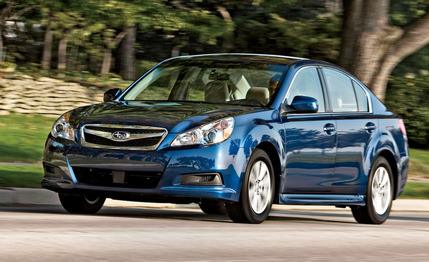 Short Take Road Test
Short Take Road Test
It’s hard to believe, but long experience has taught us that there are whole battalions of people for whom haste is a nonissue. Discerning, car-savvy people. With a keen eye for fit, finish, and materials. An industrial designer’s appreciation of ergonomics. A finely tuned sense of ride quality. But 0-to-60 mph? Hey, what’s your hurry?

If you see yourself reflected in this mirror, and you’re a candidate for a mid-size family ride, this new Legacy 2.5i should be on your list. It’s quiet, it’s roomy, it looks good (in a mid-size generic way), it’s nicely finished within, and as always, all-wheel drive is part of the deal. Haste is not.
One caution: If easy-does-it is your style, make sure you get the right 2.5. The 2.5-liter, flat-four turbo propelling the 2.5GT generates a robust 265 horsepower and 258 pound-feet of torque, enough to attain 60 mph in the low-five-second range. The naturally aspirated version—standard in the 2.5i—is much less spirited, at 170 horsepower and 170 pound-feet of torque.
We drove a 2.5i allied with Subaru’s new Lineartronic CVT automatic—it adds $1000—and hit 60 mph in 8.8 seconds. That’s faster than it feels, and there are other four-cylinder automatic sedans that won’t keep up: The Chrysler Sebring comes to mind. But it’s still pretty deliberate. The Legacy likely would be quicker with the standard six-speed manual, but the CVT promises a big advantage in fuel economy—23 mpg city and 31 highway, according to the EPA, versus 19 and 27 for the manual. This is a big deal, as the CVT Legacy is now class-competitive with the mid-size front-drivers that, Subaru says, had previously occluded the Legacy’s appeal. We averaged 25 mpg over a week, which entailed a lot of stand-on-it driving.
Sprint numbers notwithstanding, there’s a lot to like here—more than in the previous Legacy, literally and figuratively. As noted in our September preview, the fifth generation of Subaru’s mainstream sedan is bigger in every dimension. It still ranks at the small end of the mid-size-sedan parade—about the size of a Volkswagen Passat—but its increased dimensionality pays off in rear-seat space that goes from tight to comfortably habitable by three adults. There’s more room in the boot, too—15 cubic feet—and of course the rear seatbacks (split 60/40) fold forward to expand stowage.
Outside, the latest Legacy looks familiar. There’s just enough change to impart a sense of newness, tempered by the cautious styling common in this conservative class. It gets better inside, where even this entry-end car is furnished with high-quality materials, from headliner to dashboard to door panels to the cloth seat upholstery. We were bemused by the extensive use of silvery plastic trim—instead of bogus burl there is bogus aluminum—but in general this interior is classy.
Dynamically, there are no surprises, particularly of the unpleasant variety. The Legacy’s languid forward progress is matched by transient responses we’d characterize as cautious, with an occasional tremor on sharp bumps running through the otherwise solid unibody. Like most mid-size, mid-price sedans, progressive understeer is the defining dynamic trait, the trade-off for ride quality worthy of a Buick.
Grip, with a set of M+S Bridgestone Turanza EL400-02s (P205/60R-16), is just so-so at 0.81 g, and braking—186 feet from 70 mph—is lamentable, though this can be said for almost any car in this class, a strange trait for family sedans.
Subaru pricing sometimes seems a little uppity—$21,690 for a base 2.5i CVT, $22,990 as tested. That base price is higher than the get-in for the automatic-equipped base versions of the Ford Fusion, Hyundai Sonata, Mazda 6, Nissan Altima, and Toyota Camry. But remember, all-wheel drive is baked in; most of the other cars don’t even offer AWD. With that in mind, along with its other persuasive virtues, the new Legacy begins to look like a pretty attractive deal. Provided you’re not in a big hurry.